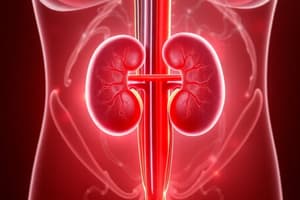Podcast
Questions and Answers
Bolos flow through kidney-aorta-segmental artery-interlobar artery- arcuate artery- interlobular artery- Afferent arteriole- glomerulus (capillaries )- efferent arterioles- ______________-interlobular vein - arcuate vein- interlobar-renal vein- inferior vena cava
Bolos flow through kidney-aorta-segmental artery-interlobar artery- arcuate artery- interlobular artery- Afferent arteriole- glomerulus (capillaries )- efferent arterioles- ______________-interlobular vein - arcuate vein- interlobar-renal vein- inferior vena cava
The kidney
The kidney
Cortex = 1.25 million nephrons Medulla = 6-18 renal pyramids PCT = Reabsorbs (H2O , ions & all organic nutrients) DCT = Secretion of ions, acids , drugs , toxins
Hormones of the kidney
Hormones of the kidney
Renin, prostaglandins + Kinins+ EPO
Nephron start to finish
Nephron start to finish
Renal
Renal
Increased Net filtration pressure = increased Glomular Filtraion rate
Increased Net filtration pressure = increased Glomular Filtraion rate
What percentage of water intake comes from beverages?
What percentage of water intake comes from beverages?
Which hormone is responsible for getting the kidney to retain sodium and water?
Which hormone is responsible for getting the kidney to retain sodium and water?
What is the biggest threat in potassium balance?
What is the biggest threat in potassium balance?
What is the source of most hydrogen ions in the body?
What is the source of most hydrogen ions in the body?
What is the primary energy source used in conditions like starving, keto, or diabetic ketoacidosis?
What is the primary energy source used in conditions like starving, keto, or diabetic ketoacidosis?
Which buffer system is the most important extracellular fluid (ECF) buffer?
Which buffer system is the most important extracellular fluid (ECF) buffer?
What is the normal range for fasting plasma glucose?
What is the normal range for fasting plasma glucose?
If GFR = 135 mL/min and plasma glucose = 355 mg/dL, what is the filtered load for glucose?
If GFR = 135 mL/min and plasma glucose = 355 mg/dL, what is the filtered load for glucose?
In response to metabolic acidosis, what is the primary action to address the imbalance?
In response to metabolic acidosis, what is the primary action to address the imbalance?
Which condition leads to metabolic alkalosis?
Which condition leads to metabolic alkalosis?
Which blood vessel carries blood away from the glomerulus?
Which blood vessel carries blood away from the glomerulus?
What is the primary function of the RAAS (Renin-Angiotensin-Aldosterone System)?
What is the primary function of the RAAS (Renin-Angiotensin-Aldosterone System)?
Which part of the kidney is responsible for the reabsorption of nutrients, plasma proteins, and ions from filtrate?
Which part of the kidney is responsible for the reabsorption of nutrients, plasma proteins, and ions from filtrate?
What is the main function of the Vasa Recta in the kidney?
What is the main function of the Vasa Recta in the kidney?
What is the primary role of the Glomerular capillaries in the renal corpuscle?
What is the primary role of the Glomerular capillaries in the renal corpuscle?
Which part of the nephron is involved in the last minute adjustments to ion, toxin, and drug secretion and reabsorption?
Which part of the nephron is involved in the last minute adjustments to ion, toxin, and drug secretion and reabsorption?
What drives the process of glomerular filtration in the kidney?
What drives the process of glomerular filtration in the kidney?
Which type of nephron is responsible for the location of the countercurrent exchange mechanism?
Which type of nephron is responsible for the location of the countercurrent exchange mechanism?
What is the main function of the Peritubular capillaries in the kidney?
What is the main function of the Peritubular capillaries in the kidney?
What is the composition of the filtrate that leaves the glomerulus during glomerular filtration?
What is the composition of the filtrate that leaves the glomerulus during glomerular filtration?
Which part of the kidney is responsible for the production and secretion of hormones such as renin and erythropoietin?
Which part of the kidney is responsible for the production and secretion of hormones such as renin and erythropoietin?
What is the location of the kidneys within the abdominal cavity?
What is the location of the kidneys within the abdominal cavity?
What is the functional unit of the kidney responsible for the production of filtrate from blood and the reabsorption of nutrients, water, and ions?
What is the functional unit of the kidney responsible for the production of filtrate from blood and the reabsorption of nutrients, water, and ions?
Which part of the kidney is responsible for the discharge of waste products into the environment?
Which part of the kidney is responsible for the discharge of waste products into the environment?
Match the following functions with their roles in the urinary system:
Match the following functions with their roles in the urinary system:
Match the following urinary system components with their locations:
Match the following urinary system components with their locations:
Match the following nephron parts with their functions:
Match the following nephron parts with their functions:
Match the following capillary types with their locations and functions:
Match the following capillary types with their locations and functions:
Match the following components with their percentage contribution to water intake:
Match the following components with their percentage contribution to water intake:
Match the following hormones with their functions:
Match the following hormones with their functions:
Match the following electrolytes with their functions:
Match the following electrolytes with their functions:
Match the following pH terms with their descriptions:
Match the following pH terms with their descriptions:
Match the following buffer systems with their characteristics:
Match the following buffer systems with their characteristics:
Match the following blood vessels with their locations in the kidney:
Match the following blood vessels with their locations in the kidney:
Match the following terms with their descriptions:
Match the following terms with their descriptions:
Match the following responses to imbalances with their correct conditions:
Match the following responses to imbalances with their correct conditions:
Flashcards are hidden until you start studying




